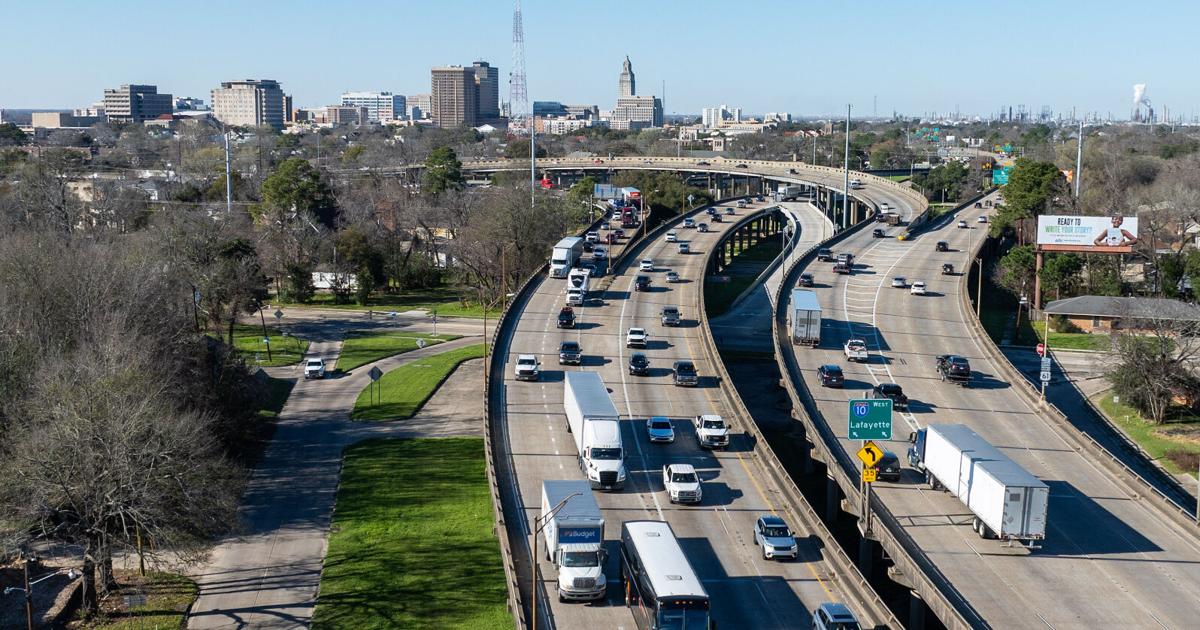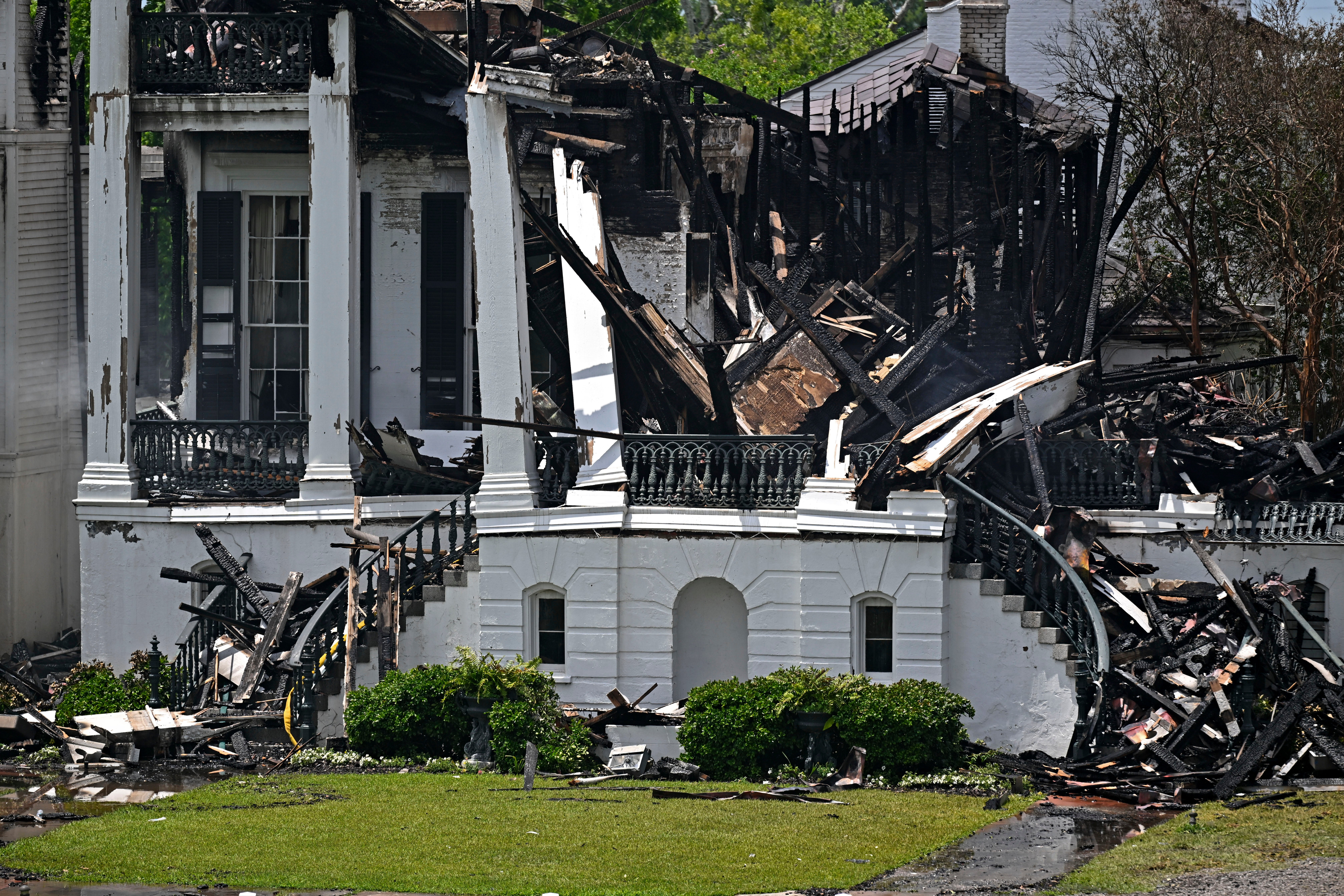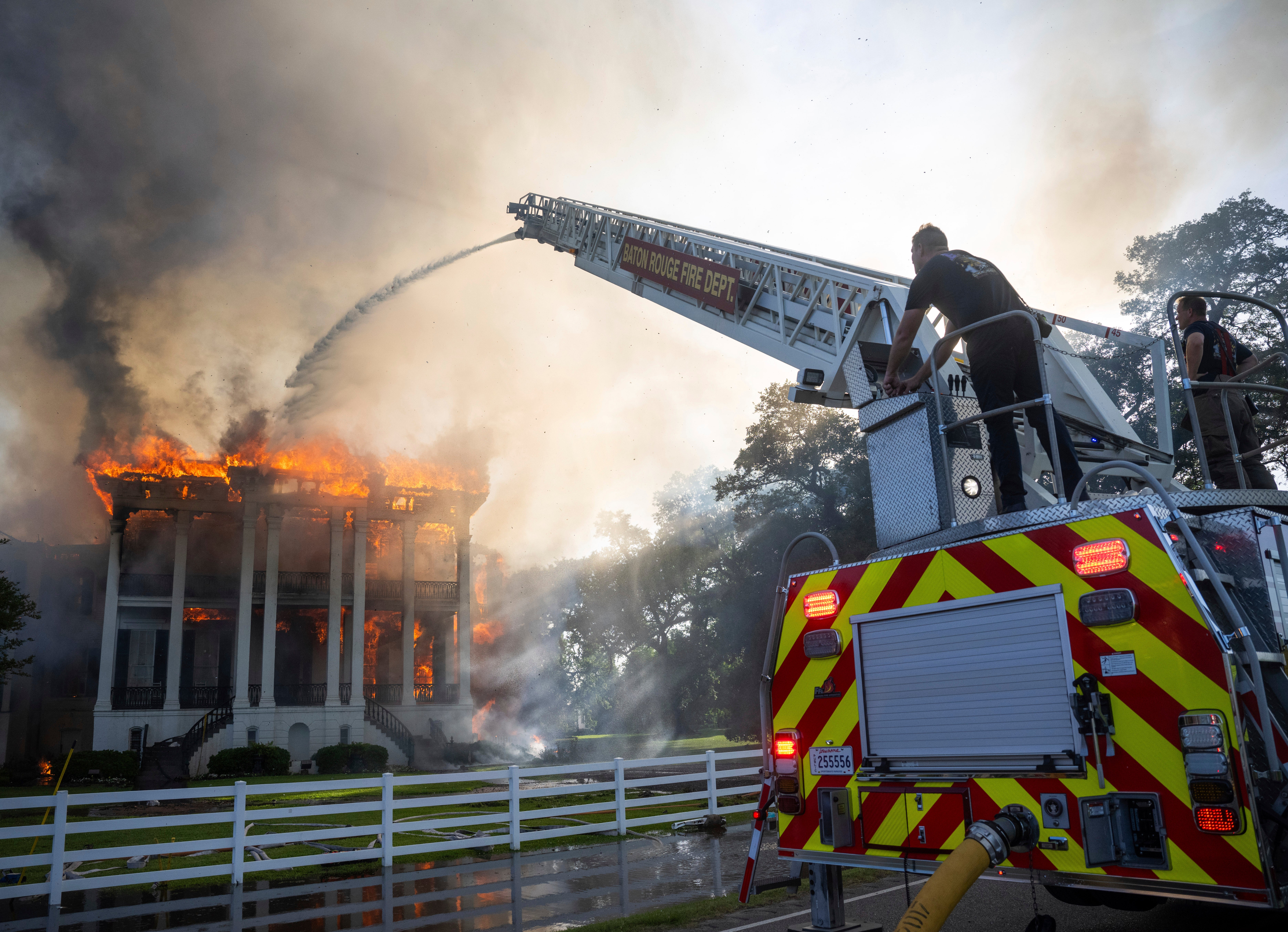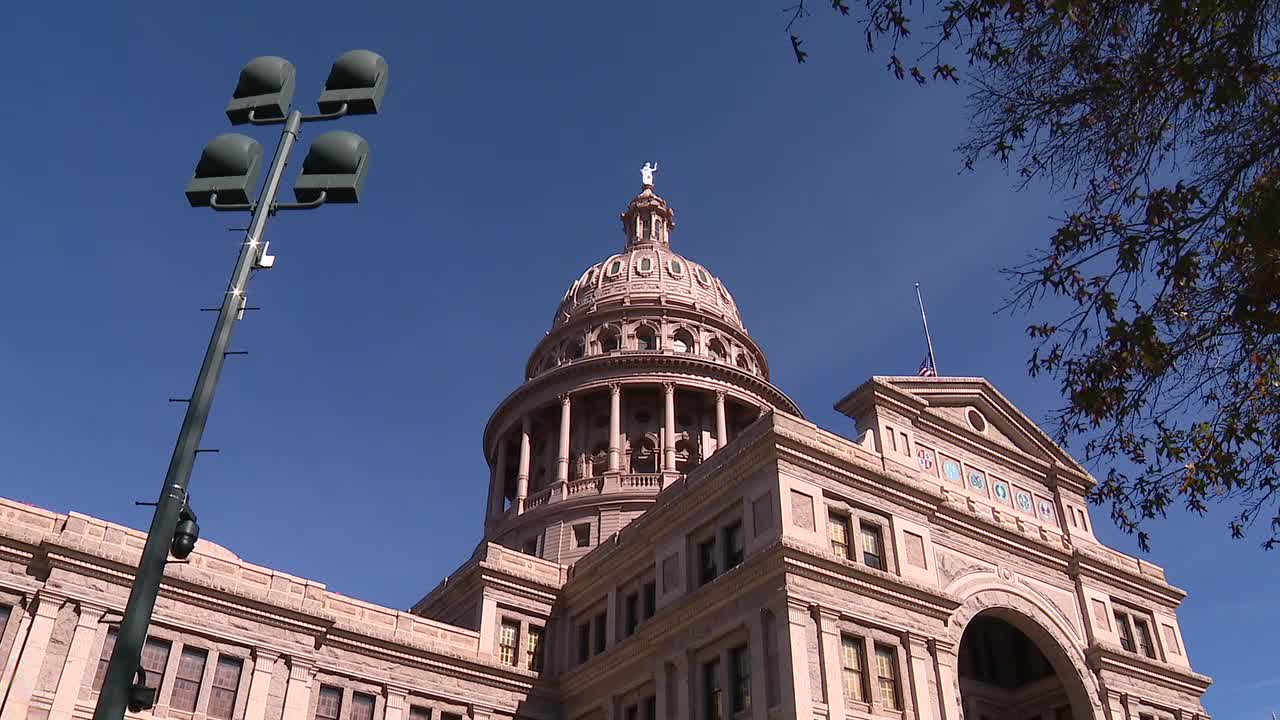Louisiana
Louisiana senators Cassidy, Kennedy still seeking flood insurance reforms

NEW ORLEANS (WVUE) – Amid increasing flood insurance costs, Louisiana’s U.S. senators say they are continuing to push for reforms to the National Flood Insurance Program.
Property owners are seeing higher flood coverage premiums, on top of soaring property insurance costs.
Katherine Drezek is a Louisiana homeowner who said she has seen her flood insurance premium rise in recent years.
“Yes, I think all the insurance has gone up, not only flood insurance. Fire insurance, just the house insurance period, has gone up,” she said.
Still, Drezek has not considered dropping her flood coverage.
“No, I live too close to the lake not to have flood insurance. I mean we live in Louisiana, we need flood insurance,” Drezek said.
With Congress in recess, Republican senators Bill Cassidy and John Kennedy were speaking Tuesday (Aug. 20) in the New Orleans area.
Cassidy toured Wrstbnd, a company in the Elmwood section of Jefferson Parish, after he spoke to the River Region Chamber of Commerce. And on the north shore, Kennedy addressed the St. Tammany Chamber.
“We need to fix the flood insurance program. The first thing we need to do is expand it,” Kennedy said.
Only a fraction of the properties in the U.S. are covered through the National Flood Insurance Program. According to FEMA, the NFIP protects more than $1.28 trillion in assets through nearly 5 million policies.
“We’ve got about 5 million people across America that’s got flood insurance. That’s not enough,” Kennedy said. “That’s not enough, because the more people you have, the more risk you can spread.”
Fox 8 asked Cassidy if there should be an effort to get more properties covered by flood insurance.
“There should be,” he said. “Banks are supposed to require it if homes are at risk. One thing we know is that more homes are at risk. So, for example, more people are building next to the coast. People want to live next to the water, and so that almost inherently puts them at risk.”
But he added that high costs are keeping some property owners from either acquiring or keeping flood insurance.
“On the other hand, if the premium is so expensive people can’t afford it, it drops off,” Cassidy said.
Cassidy said he wants Congress to mandate FEMA to take into account more levees when determining flood insurance rates.
“Right now, if a levee works but it’s not federally recognized, FEMA does not include that levee in their kind of risk assessment,” Cassidy said. “But the levee works. People can show flood water on one side, dry homes on the other. So, we would require FEMA to begin taking into account these non-federally recognized levees which work.”
Kennedy said, “I’m for creating some sort of national catastrophe fund that includes flood, that includes fire, earthquake. That’s harder to do than it sounds, but you get 15, 20, 30 and 40 million people in a fund, you can spread the risk better than you can with only five million.”
Under Risk Rating 2.0, the methodology FEMA has been using in recent years to determine premiums, rates can legally be increased up to 18% a year.
“This algorithm apparently can look into the future and tell whether your home is going to flood 45 years from now. I don’t believe it. I think it was an excuse to raise premiums,” Kennedy said.
With U.S. House members and some senators up for reelection in November, pundits say Congress will hesitate to pass consequential legislation before the end of the year.
On the prospects of getting NFIP reforms approved this year, Cassidy said, “I can’t tell you that it’s going to happen, but I can tell you that we’re in active negotiation as to how we could help lower-income Americans afford their flood insurance.”
Kennedy concedes that reaching a consensus on how to change the program will be difficult.
“We need to fix it,” he said. “But it’s not easy to do, because you’ve got a lot of people who, first, don’t care. They’re in a state that’s never flooded. And No. 2, we’ve got a lot of different points of view about how to fix it.”
Drezek said she has a message for Congress.
“Lower it. Please, please, please lower the insurance,” she said.
Kennedy said Congress will not let the program expire.
See a spelling or grammar error in our story? Click Here to report it. Please include the headline.
Subscribe to the Fox 8 YouTube channel.
Copyright 2024 WVUE. All rights reserved.

Louisiana
The Louisiana Senate passes contentious car insurance bills. See who won and who lost.

Gov. Jeff Landry showed who’s the boss at the State Capitol when he rammed a car insurance bill through the Senate late Wednesday night over the vehement objections of Insurance Commissioner Tim Temple and business trade groups.
House Bill 148 would grant the insurance commissioner greater authority to reject “excessive” rate increases, which Landry has said several times would prompt him to blame Temple if rates remain high. With a last-minute amendment sought by the governor, HB148 also would require insurance companies to make their rate filing requests public. They say this could force them to expose trade secrets.
But balancing out the scales, the Senate also passed five bills that affect who can sue and how much they can collect – measures that Temple, the insurance industry and their business allies say would reduce payouts and thus reduce rates. The Senate passed the bills over the opposition of trial lawyers and their Democratic allies.
“What just passed out of the Senate, and if passed into law, would be the most comprehensive insurance reform in Louisiana’s history,” said Sen. Patrick McMath, R-Covington. “These changes are geared toward addressing the unaffordable car insurance crisis in Louisiana.”
Sen. Jay Luneau, D-Alexandria, offered a different take.
“We’re just taking away more people’s rights, and rates won’t go down,” he said, adding that the Senate’s rush to approve bills with late changes “leads to bad legislation.”
Temple supported the pro-insurance industry bills that passed but slammed the rate increase bill.
“It’s a false claim that rates are high because the commissioner doesn’t have some magical power,” he said. “It doesn’t address the fundamental problem in Louisiana – bodily injury and legal abuse.”
In sum, senators said, Landry emerged as the big winner politically, while Temple and the insurance industry appear to have had mixed results, with trial lawyers seemingly on the losing end.
Wednesday’s late night action sets up Landry to sign a raft of car insurance bills as early as Wednesday next week, legislative sources said.
He will sign all five bills passed by the Senate Monday night, the governor’s office said Thursday, although whether all five bills will have won final House approval by then is not clear.
The fight over how to address high car insurance rates has been the highest profile political battle since the legislative session began in mid-April.
Landry and legislators have been pulled by both sides throughout, with Temple and his business allies on the offensive and trial lawyers and their allies playing defense.
The governor has repeatedly positioned himself in the middle, saying he doesn’t like billboard lawyers (although he went turkey hunting in Texas with several prominent trial attorneys just before the session began) but also believes that insurance companies are earning big profits in Louisiana.
In a speech Thursday in New Iberia, Landry said a study by the National Association of Insurance Commissioners shows that Louisiana is an outlier on one key metric: “Our minor injury claims are double the national average,” he said.
Temple has said Louisiana has had twice as many minor injury claims as New York even though that state counts five times as many residents.
Senate President Cameron Henry has been talking with Landry and Senate colleagues for days about how to handle the nearly 20 pro-insurance industry bills that passed the House.
Henry, R-Metairie, outlined his plans to Republican colleagues Wednesday afternoon in a private meeting in the Senate dining room: the Senate would approve five bills.
House Bill 450 by Rep. Michael Melerine, R-Shreveport, would require someone who sued over injuries in a car accident to show that the injuries actually occurred during the accident. HB450 goes to Landry for his signature.
House Bill 434 by Rep. Jason DeWitt, R-Alexandria, would disallow a driver without car insurance from collecting an award for bodily injury medical expenses for any amount below $100,000, up from $15,000 today. HB434 also goes to Landry for his signature.
House Bill 431 by Rep. Emily Chenevert, R-Baton Rouge, would bar drivers responsible for at least 51% of an accident from receiving a damage award to cover their injuries. Under current law, a driver responsible for, say, 51% of the accident can collect a payment equal to 49% of the overall damage award. Because of an amendment added to the bill, HB431 needs House approval before it can become law.
House Bill 436 by Rep. Gabe Firment, R-Pollack, would prohibit undocumented immigrants who are injured in car accidents from collecting general damages. HB436 requires the House to accept the Senate changes to the bill.
Senate Bill 231 by Sen. Mike Reese, R-Leesville, would allow lawyers for insurance companies to tell jurors how much people injured in wrecks actually pay in medical bills. Under current law, jurors hear the total amount billed, regardless of what the plaintiff paid. A House committee is slated to take up SB231 next week.
Temple said HB431, HB450 and SB231 would “move the needle forward.”
Senate Democrats argued against the five bills, saying the Legislature has passed a host of pro-industry bills over the years, yet rates never come down.
Luneau, Sen. Sam Jenkins of Shreveport and Sen. Royce Duplessis of New Orleans all offered amendments to the Republican-sponsored bills that, if passed, would mandate a 2% reduction in rates. Republicans rejected those amendments on each bill.
Democrats also pointed to an April report by the National Association of Insurance Commissioners which said that in 2023, insurance companies in Louisiana had the third highest underwriting profit, the fourth lowest loss ratio and the fifth highest return on net worth.
As part of Henry’s plan, the Senate also would adopt HB148 – the measure that Landry most wanted and that Temple didn’t want – after it had been amended.
HB148 is the only bill Landry testified in favor of during the legislative session, saying last month that Temple should want to have greater authority to hold down rates.
Senators expressed reluctance privately in recent days to advance the bill because it didn’t require the commissioner to cite actuarial data in rejecting proposed rate increases.
But Landry lobbied hard to get them to approve it Monday night, senators said Thursday. The amended version now includes actuarial language.
Sen. Kirk Talbot, a River Ridge Republican and a close friend of Henry’s, pushed the bill through the Senate.
That task fell to Talbot even though he has been one of the insurance industry’s strongest allies.
Talbot didn’t return a phone call Thursday.
HB148 returns to the House for approval of the Senate changes.
Louisiana
Louisiana Republicans reject bill that would address split jury verdicts, a Jim Crow-era practice – WTOP News

BATON ROUGE, La. (AP) — A Louisiana bill that would have carved out a path for incarcerated people convicted by…
BATON ROUGE, La. (AP) — A Louisiana bill that would have carved out a path for incarcerated people convicted by now-banned split juries the opportunity to ask for a new trial was rejected by Republican state senators on Wednesday, likely killing the measure.
An estimated 1,000 people behind bars in the Deep South state were convicted by non-unanimous juries, a practice rooted in racism from the era of “Jim Crow” laws and deemed unconstitutional by the U.S. Supreme Court in 2020. Advocates say it is past time for Louisiana to right a wrong and to give those people a chance at a fair trial.
Proponents of the bill pointed to multiple examples of innocent people — since exonerated — who were wrongfully convicted by split juries and spent decades in prison. Supporters said the measure could have created a way for any other possibly innocent people behind bars who had been convicted by non-unanimous juries to seek another chance for a fair trial.
The bill would have added non-unanimous verdicts to a list of claims for which an inmate can seek a retrial. Proponents reiterated that the legislation would only have created the opportunity to do so and that it would not have automatically granted a retrial or release.
During debate in the state Senate on Wednesday, Republican lawmakers raised concerns about overburdening courts and district attorneys with additional trials. Proponents said whether a new trial is granted is ultimately at the discretion of district attorneys.
Opponents also raised concerns about the cases being decades-old with some witnesses possibly dead or evidence lost. Supporters countered that old cases are tried all the time and that transcripts of testimony from the original trials could be used.
“This is about what’s right, not about what’s easy or convenient,” Sen. Royce Duplessis, the New Orleans Democrat who authored the bill, said to his colleagues.
Louisiana adopted the practice of split jury convictions in 1898 during a constitutional convention that was fueled by efforts to maintain white supremacy after the Civil War. Diluting the voice of Black jurors allowed the often-white majority to determine the outcome.
Louisiana voters did not get rid of the practice until 2018, two years before the Supreme Court ruled that it was a violation of the 6th Amendment’s guarantee of the right to an impartial jury.
At the time, Louisiana and Oregon were the only states that allowed split decisions — 10-2 or 11-1 jury votes — to result in convictions. The Oregon Supreme Court granted new trials to hundreds of people. But Louisiana’s Supreme Court rejected arguments to apply the ruling retroactively.
“If we choose to vote down this bill we’re saying that justice has an expiration date,” Duplessis said. “We have an opportunity in Louisiana to remove this stain, because right now we are the only ones wearing it.”
The bill failed on a vote of 9-26, along party lines. Given the overwhelming lack of support for the bill in the Senate and that there is only a month left in this year’s Legislative Session, the measure currently has no viable path forward and is likely dead.
Copyright
© 2025 The Associated Press. All rights reserved. This material may not be published, broadcast, written or redistributed.
Louisiana
Why a plantation house fire ignited a heated debate over slavery’s legacy

A fire that ravaged Nottoway Plantation, one of the Deep South’s largest pre-Civil War mansions, sparked a wave of mixed reactions online, ranging from jubilation to dismay. The Louisiana landmark, where countless enslaved Africans once toiled, became a symbol of conflicting emotions as video footage of the blaze spread across social media.
For some, the fire represented a form of belated justice for the suffering endured by enslaved ancestors. The internet buzzed with memes and celebratory posts, some featuring the burning mansion set to Usher’s “Let It Burn,” while others amplified the crackling sounds of the fire to evoke a sense of catharsis.
Historian Mia Crawford-Johnson captured the sentiment with a grinning selfie taken near the charred remains, captioned, “Went and watched (Nottoway Plantation) burn to the ground!”
However, the fire also brought sadness to some. Nottoway Plantation had served as a popular venue for weddings and other celebrations, holding cherished memories for many. The destruction also represents a significant loss of historical record, erasing the physical testament to the ingenuity and skill of the enslaved people who built and maintained the plantation.
Preservationists say the jubilant reactions to the charred mansion reflect the trauma and anger many people, especially Black Americans, still carry over the history and legacy of chattel slavery in the United States. Antebellum era plantations were built under grueling conditions on the backs of enslaved people, and many are now sites of honor on the National Register of Historic Places.

Some plantations try to ignore their past
But some plantations also de-emphasize or overlook their full histories, foregoing mentions of slavery altogether. That is why the “good riddance” sentiment seemed to outweigh expressions of grief over Nottoway Plantation, which makes no mention of enslaved former inhabitants on its website.
Many sites of enslavement in the U.S. have been repurposed as places that actively participate in the erasure of their history, said Ashley Rogers, executive director of the Whitney Plantation Museum, located 40 miles (65 kilometers) west of New Orleans. She said the burning of Nottoway is not actually part of the movement for preservation, since nothing was truly being done on the property to tell its full history.
“It was a resort,” Rogers said. “I don’t know that it being there or not being there has anything to do with how we preserve the history of slavery. They already weren’t.”
Joseph McGill, executive director of the Slave Dwelling Project, a nonprofit focused on helping the U.S. acknowledge its history with slavery, said the reaction from the Black community about Nottoway burning represents years of complicated emotions related to plantations. But as a preservationist, McGill said it is unfortunate Nottoway burned down, even if it was failing at telling history.
“I would like to see buildings preserved so that those buildings could tell the stories of all the people who inhabited those spaces,” McGill said. “We have been failing at that, but at least when the buildings are there the opportunity always exists to do the right thing.”
Nottoway Plantation became a resort and event venue
Before the fire, Nottoway was a resort and event venue, and its website described it as “the South’s largest remaining antebellum mansion.” Iberville Parish President Chris Daigle called the plantation “a cornerstone of our tourism economy and a site of national significance.”
The sprawling property exists on a former sugar plantation owned by sugar baron John Hampden Randolph. Located about 65 miles (105 kilometers) northwest of New Orleans, the 53,000-square-foot (4,924-square-meter) mansion had a three-story rotunda adorned with giant white columns and hand-carved Italian marble fireplaces, according to a description on its website. A brochure advertises 40 overnight rooms, a honeymoon suite, a lounge, fitness center, outdoor pool and cabana, among other resort features.

In 1860, 155 enslaved people were held at the property, National Park Service records show.
After the blaze, which drew an emergency response from nearly a dozen fire departments from surrounding towns, the property’s owner said the fire had led to a “total loss” and that he hoped to rebuild the mansion.
Rogers said it is unfortunate Nottoway’s mansion burned down, as it did serve as a testament to the “skill of enslaved craftspeople and free people of color who built it and who did a lot of the incredible design work that was inside of that building.”
There are plenty of plantations, unlike Nottoway, that do not allow weddings or other celebratory events. For example, the Whitney, which documents slavery at a pre-Civil War plantation, draws tens of thousands of visitors annually and is known for centering the stories of enslaved people.
The Nottoway fire has also restarted a public discourse over plantations. Rogers, the Whitney museum director, said this is not new discourse, but can feel like such because there are not many places where productive conversations can be had about slavery and how to tell its history.
Racism and slavery dominate cultural debates
How, where and when to talk about the history of U.S. racism and slavery has dominated political and cultural debates in recent years. An executive order issued in March by the Trump White House seeks to root out “divisive, race-centered ideology” in the Smithsonian Institution, which operates a broad range of cultural centers in Washington. Among the order’s targets is the National Museum of African American History and Culture, a popular Smithsonian attraction that chronicles chattel slavery, Jim Crow segregation and its lingering effects.
Relatedly, plantations and other national historic sites with ties to civil rights have long been places where visitors and descendants of enslaved people go to learn about the past. But they are also places where visitors may encounter naysayers and deniers challenging the tour guide’s presentation about slavery.
Rogers said there are plenty of others sites besides Nottoway accurately telling Black history that need to be preserved.
“I don’t think one plantation burning down is going to change how we talk about slavery in this country,” she said. “All it does is exposes wounds that are already there.”
-

 Education1 week ago
Education1 week agoHarvard Letter Points to ‘Common Ground’ With Trump Administration
-

 Culture1 week ago
Culture1 week agoBook Review: ‘Original Sin,’ by Jake Tapper and Alex Thompson
-

 News1 week ago
News1 week agoAs Harvard Battles Trump, Its President Will Take a 25% Pay Cut
-

 News1 week ago
News1 week agoAustin Welcomed Elon Musk. Now It’s Weird (in a New Way).
-

 Culture1 week ago
Culture1 week agoBook Review: ‘Death Is Our Business,’ by John Lechner; ‘Putin’s Sledgehammer,’ by Candace Rondeaux
-

 Education1 week ago
Education1 week agoVideo: Opinion | We Study Fascism, and We’re Leaving the U.S.
-

 News1 week ago
News1 week agoMenendez Brothers Resentenced to Life With Parole, Paving Way for Freedom
-

 Politics1 week ago
Politics1 week agoRepublicans say they're 'out of the loop' on Trump's $400M Qatari plane deal


















